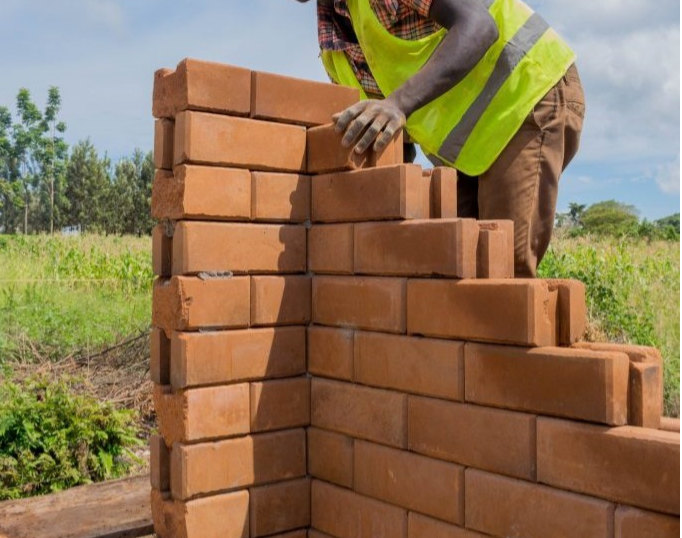Mauricia Nambatya (Haileybury Youth Trust)
Mauricia Nambatya is a Civil Engineer with an MPhil in Engineering for Sustainable Development from the University of Cambridge, and a First Class Honours BSc in Civil Engineering from Makerere University, Kampala. She advocates for climate-friendly building construction to reduce the use of fired bricks that have massively contributed to deforestation.
The Haileybury Youth Trust (HYT) operates in Uganda and trains young Ugandans to create and work with innovative, carbon-saving building technology to improve education, opportunity, and livelihoods. Read on to learn more about the environmental and social benefits of using Interlocking Stabilised Soil Blocks (ISSBs) for building schools.
What is ISSB?
ISSB stands for Interlocking Stabilised Soil Block, a form of compressed earth block that is stabilised with cement and has an interlock feature that allows the blocks to be dry stacked without or with considerably less mortar between the courses.
Instead of being burned, the blocks are air-cured. With an 80% greater compressive strength than burnt bricks , they are more resilient than burnt bricks and even more economical per square metre, saving up to 40% on dry stacking and less mortar needed for rendering and plastering.
ISSBs are made from a mix of subsoil (free from humus) with sand and cement, to which a little water is added. The mixture is then compacted in a manual block-making machine.
Conventionally, most school structures in Uganda are built with burnt bricks that are bonded with mortar of up to 30 mm. ISSBs are a suitable walling alternative to the environmentally damaging burnt brick. ISSBs are cured rather than fired, reducing deforestation that results from brick kiln burning.

Types of ISSB
An ISSB can either be straight or curved, depending on the specific machine mould used. Straight blocks are used mostly for rectangular structures. These blocks are strong and durable and are used to build permanent structures in schools, e.g., classrooms, latrines, and staff accommodation.
Curved blocks are often used for constructing rainwater harvesting tanks that store the water guttered off the building roof. School children are saved from the long distances they regularly make to fetch water for school use, and handwashing is easily enforced.
If you choose to use ISSBs, it is vital to ensure a skilled ISSB mason leads the block production to control soil selection, the mix ratios, and consistency of mixing, and to ensure blocks are pressed and fully cured. During walling, at least the first two courses above the damp-proof course should be plastered to protect the blocks from any backsplash from the apron. Furthermore, a large overhang will protect the blocks further. Compressive strengths of ISSBs above 2.5–7 megapascals (MPa)–have been achieved based on the structural design.
A three-classroom block, with ISSBs exposed (African Revival and HYT)

Curved ISSB used in the construction of rainwater harvesting tank

Benefits of using ISSBs
The use of ISSB has been recognised with different awards in the field of sustainable buildings around the world. Part of this recognition is thanks to the holistic model proposed by HYT where communities are empowered with knowledge and skills to protect the environment.
Other advantages of using this building material include:
- ISSB scaling is gaining ground. It has progressed through partnerships with organisations focused on sustainable construction. Once a pilot project with construction using ISSB is completed, more projects follow.
- Construction using ISSBs saves all the trees that would otherwise be cut to burn traditional bricks. As a reference, 14 tonnes of firewood are needed for every 10,000 bricks burnt in a kiln, translating to 3.5 mature trees with a 1.5-foot basal diameter (⇡Oteng’i & Neyole, 2007).
- Users of classrooms built with ISSBs find them cooler than the outside of the building and so experience good thermal comfort. This can partly be attributed to classroom cross-ventilation, but is also thanks to the material used to make ISSBs, which is largely subsoil. A study comparing temperatures and how students feel in classrooms built with ISSBs and burnt brick, respectively, should be considered.
- Water tanks made with curved ISSBs are more robust and durable than the plastic alternatives found in many schools, which are often damaged.
Environmentally conscious organisations are increasingly interested in the environmental and socio-economic advantages of using ISSBs. Moreover, the Haileybury Youth Trust offers training to upskill locals and young people in creating and using ISSBs, further improving employment opportunities. There is feedback to show that school users enjoy structures made with ISSBs, allowing them to study in more comfortable classroom spaces.
Challenges
- Most tenders continue to specify burnt clay bricks in the Bills of quantities (BoQs) for superstructure walling, and the procurement process excludes ISSBs and other innovative walling materials. Architects must be brought on board to influence the specifications on drawings and BoQs. Furthermore, more sensitisation of clients is required.
- Production of ISSBs requires skilled builders to find the right composition of building materials. It is necessary to ensure the capacity of building communities before this type of block is used to build schools.
- Unit costs of ISSBs might be pricier than burnt bricks; nevertheless, costs are reduced when ISSBs are used in large quantities, for instance in the construction of several schools across the country.
The benefits of using ISSBs have yet to be promoted sufficiently across the education, environment, and school infrastructure communities in East African countries. More dissemination work is required to bring government, private, public, and non-governmental (NGO) sectors on board for pushing forward climate-resilient school buildings.
Reference
Oteng’i, S. B. B., & Neyole, E. M. (2007). Brick Making Activities and their environmental Impacts in Busia, Siaya, Bondo and Butere-Mumias Districts of the Lake Victoria Basin of Kenya. 1, 24–28.

